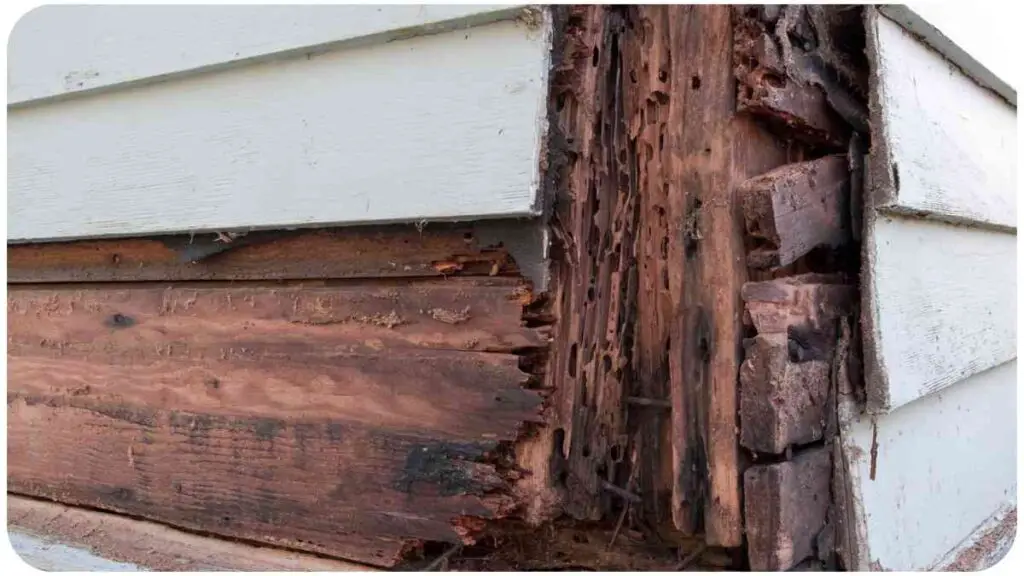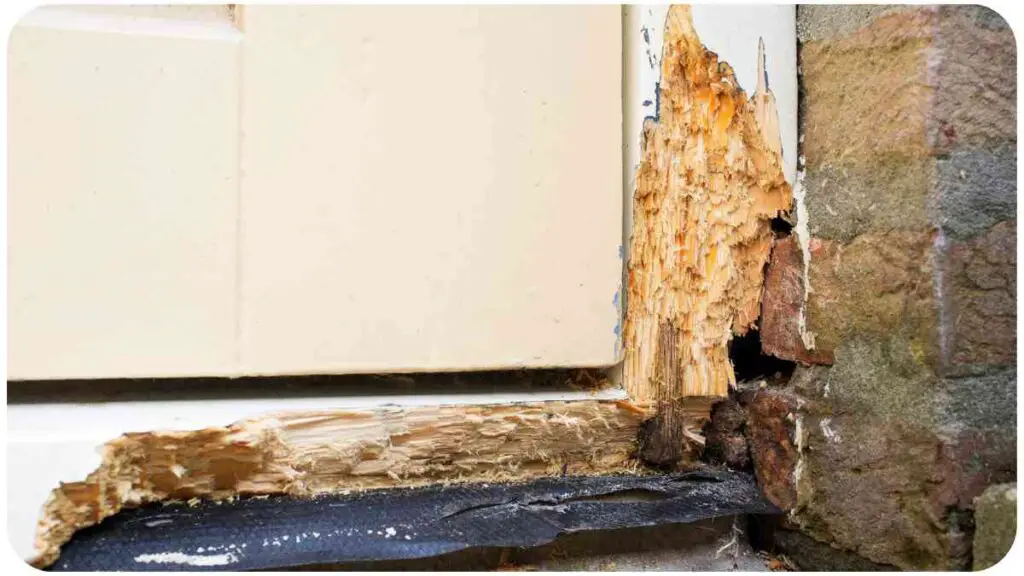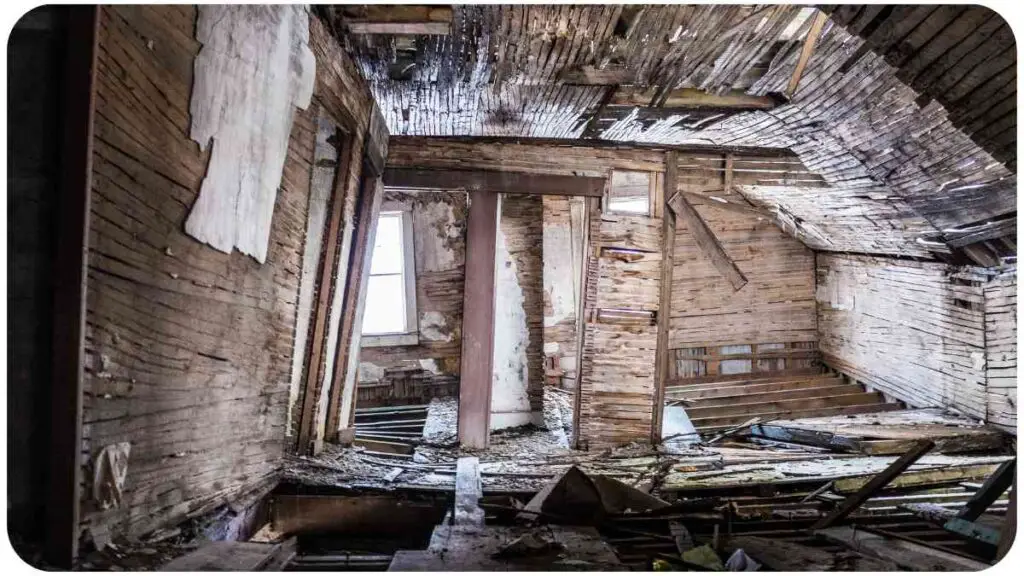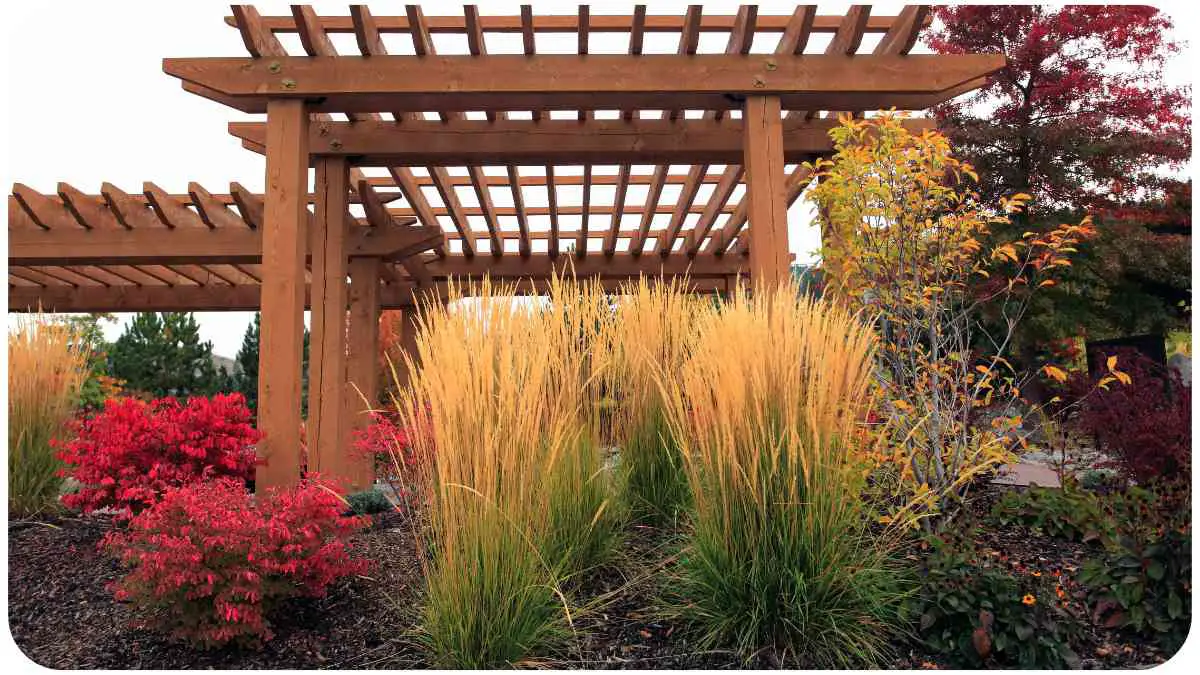Garden structures like pergolas and arbors can add a touch of elegance to your outdoor space, but what happens when they start wobbling like a poorly balanced chair? In this comprehensive guide, we’ll explore the common reasons behind wobbly garden structures and provide practical solutions to fix them.
Whether you’re a seasoned DIY enthusiast or a novice gardener, this article will equip you with the knowledge and tools needed to restore stability to your outdoor haven.
| Takeaways |
|---|
| 1. Regular inspections are essential for identifying and addressing stability issues early on. |
| 2. DIY fixes, such as tightening loose fasteners and repairing warped wood, can be effective for minor issues. |
| 3. Consider professional assistance, especially for complex structural problems or foundation issues. |
| 4. Choose quality materials like pressure-treated wood or metal for long-lasting and stable garden structures. |
| 5. Implement preventive measures, including routine maintenance and proper installation techniques, to ensure longevity. |
2. Understanding the Causes of Wobbliness
Wobbly garden structures can be a source of frustration, but understanding the root causes is the first step toward a sturdy solution.
Maintaining the health of your garden structures goes hand in hand with fungal disease prevention. Recognizing early signs and implementing treatments ensures a thriving environment for both plants and structures.
2.1. Foundation Issues
A shaky foundation can undermine the stability of any structure. If your pergola or arbor is built on uneven ground or lacks a solid base, it may wobble. To address this, consider stabilizing the foundation through techniques such as adding support beams or adjusting the ground level.
Table 1: Foundation Assessment Checklist
| Assessment Point | Action Required |
|---|---|
| Uneven Ground | Level the ground surface |
| Lack of Support Beams | Add support beams |
| Ground Shifting or Settling | Address underlying issues |
2.2. Loose Fasteners
Over time, fasteners can become loose due to weathering or poor initial assembly. Regular inspection and tightening of nuts, bolts, and screws are crucial for maintaining stability.
A well-maintained garden includes proper care for both plants and structures. Discover DIY maintenance tips to ensure a clear water flow in your garden fountain, enhancing the overall aesthetic appeal.
Table 2: Fastener Inspection Guide
| Fastener Type | Inspection Method | Tightening Procedure |
|---|---|---|
| Nuts and Bolts | Check for visible rust or corrosion | Use appropriate tools to tighten |
| Screws | Inspect for stripped or damaged heads | Replace damaged screws |
| Anchors | Ensure they are securely attached to wood | Re-anchor if necessary |
2.3. Warping or Rotting Wood

Wood, while a beautiful and natural choice for garden structures, is susceptible to warping and rot. Exposure to the elements can accelerate these processes, leading to instability.
Table 3: Wood Condition Assessment
| Wood Type | Inspection Method | Remedial Action |
|---|---|---|
| Warped Wood | Measure deviations from original shape | Consider reinforcement or replacement |
| Rotted Wood | Probe with a screwdriver for soft spots | Cut out and replace with new wood |
| Overall Condition | Check for signs of mold, fungi, or insect damage | Treat or replace affected sections |
2.4. Poor Assembly
Sometimes, wobbliness is the result of poor initial assembly. This could be due to rushed construction, inadequate tools, or insufficient expertise.
Stability of garden structures is closely tied to effective drainage. Explore common issues and fixes to enhance your garden’s drainage system, promoting the longevity of structures like pergolas and arbors.
Table 4: Assembly Quality Evaluation
| Assembly Element | Inspection Criteria | Corrective Measures |
|---|---|---|
| Joints | Ensure proper connections and alignments | Reassemble or reinforce joints |
| Support Beams | Verify secure attachment to main structure | Add additional support if needed |
| Overall Quality | Check for signs of structural weakness or damage | Reinforce weak points or rebuild |
By identifying the specific cause of the wobbliness, you can tailor your approach to address the underlying issue effectively.
3. Tools and Materials You’ll Need
Now that you’ve identified potential causes, let’s gather the tools and materials necessary for the repair process.
3.1. Basic Toolkit
Every DIY enthusiast should have a basic toolkit on hand for small repairs. Here’s a checklist to ensure you’re well-equipped:
Table 5: Basic Toolkit Checklist
| Tool | Purpose |
|---|---|
| Screwdriver set | Tightening screws and bolts |
| Adjustable wrench | Turning nuts and bolts |
| Hammer | Nailing and minor adjustments |
| Level | Checking and correcting uneven surfaces |
| Tape measure | Taking accurate measurements |
| Wood glue | Bonding and reinforcing wood components |
| Drill and bits | Making holes for screws or anchors |
3.2. Additional Materials for Specific Issues
If you’ve identified particular problems, you may need additional materials for targeted repairs.
Leaks can pose threats to both garden structures and nearby plants. Learn comprehensive techniques for fixing garden hose connections, addressing potential water-related damages and preserving the integrity of your outdoor space.
Table 6: Additional Materials Checklist
| Material | Purpose |
|---|---|
| Support beams | Stabilizing and reinforcing the foundation or main structure |
| Replacement wood | Substituting damaged or rotted wood components |
| Anti-rot treatment | Protecting wood from rot and decay |
| Anchors and fasteners | Securing the structure to the ground or connecting components |
| Epoxy resin | Filling gaps or reinforcing joints |
With your toolkit and materials ready, let’s move on to the inspection and assessment phase.
4. Inspection and Assessment

Now that we have our tools and materials in order, it’s time to inspect and assess the wobbly garden structure to determine the best course of action.
4.1. Checking the Foundation
The foundation serves as the backbone of any stable structure. Use the Foundation Assessment Checklist (Table 1) to systematically evaluate potential issues.
Tip: If the ground is uneven, consider using a level to identify high and low points. This will guide your efforts in leveling the surface.
Similar to wobbly garden structures, patio cracks demand attention. Follow this step-by-step guide to repair cracks effectively, ensuring the stability and durability of your outdoor living space.
4.2. Examining Fasteners
Loose fasteners are a common culprit for wobbly structures. Follow the Fastener Inspection Guide (Table 2) to identify and address any issues.
Tip: Use penetrating oil to loosen rusted nuts and bolts before attempting to tighten them.
4.3. Inspecting Wood Conditions
Wood is a beautiful but vulnerable material. Go through the Wood Condition Assessment (Table 3) to assess the state of the wood components.
Tip: Pay attention to joints and areas where water may accumulate, as these are common trouble spots.
4.4. Evaluating Assembly Quality
Lastly, evaluate the overall quality of the assembly using the Assembly Quality Evaluation (Table 4) to identify any structural weaknesses.
Tip: Enlist a friend to help with the evaluation, as an extra set of eyes can catch things you might miss.
With the inspection complete, we can now move on to addressing specific issues and implementing DIY fixes. Stay tuned for the next section where we delve into practical solutions for common problems.
5. DIY Fixes for Common Issues
Armed with a thorough inspection, it’s time to roll up our sleeves and tackle the wobbliness head-on. Here are DIY fixes for the most common issues identified during the assessment.
5.1. Stabilizing the Foundation
A shaky foundation can undermine the entire structure. Let’s explore ways to stabilize it.
Table 7: Foundation Stabilization Methods
| Issue | DIY Fix |
|---|---|
| Uneven Ground | Add compacted soil or gravel to level the surface |
| Lack of Support Beams | Install additional support beams beneath the structure |
| Ground Shifting/Settling | Address underlying soil issues or use pavers for stability |
Tip: Consider using a concrete mix for added stability, especially in areas prone to ground shifting.
5.2. Tightening Loose Fasteners
Loose fasteners can contribute significantly to wobbliness. Let’s tighten things up.
Table 8: Fastener Tightening Techniques
| Fastener Type | DIY Tightening Method |
|---|---|
| Nuts and Bolts | Use a wrench or socket to tighten securely |
| Screws | Replace stripped screws or use larger screws for a more secure fit |
| Anchors | Re-anchor using larger or additional anchors for stability |
Tip: Apply a thread-locking compound to screws and bolts to prevent them from loosening over time.
5.3. Repairing Warped or Rotted Wood
Warped or rotted wood compromises the structural integrity. Let’s address these issues with targeted repairs.
Table 9: Wood Repair Techniques
| Wood Issue | DIY Repair Method |
|---|---|
| Warped Wood | Use clamps or heavy objects to straighten warped sections |
| Rotted Wood | Cut out the affected area and replace with new wood |
Tip: Apply wood filler to small cracks or gaps in addition to reinforcement for a seamless finish.
5.4. Reinforcing Poorly Assembled Structures
Poor assembly can lead to weak points. Let’s reinforce the structure for lasting stability.
Table 10: Structural Reinforcement Strategies
| Weak Point | DIY Reinforcement Technique |
|---|---|
| Joints | Add metal brackets or braces for additional support |
| Support Beams | Attach additional beams or use metal brackets for reinforcement |
| Overall Structure | Apply wood glue to joints and use screws for a stronger connection |
Tip: Consider adding decorative elements that also serve as reinforcement, enhancing both form and function.
With these DIY fixes, you’re well on your way to restoring stability to your garden structure. In the next section, we’ll explore professional solutions for cases where DIY might not suffice. Stay tuned!
6. Professional Solutions
While DIY fixes are effective for many wobbly garden structures, there are instances where professional intervention becomes necessary. Let’s explore the scenarios where calling in the experts is the best course of action.
6.1. Consulting a Structural Engineer
When the wobbliness persists despite your DIY efforts, it’s time to consult a structural engineer. They possess the expertise to assess the structural integrity of the entire setup and recommend targeted solutions.
Table 11: Signs It’s Time to Consult a Structural Engineer
| Signs of Concern | When to Consult a Structural Engineer |
|---|---|
| Persistent Wobbliness | Despite DIY fixes, the structure remains unstable |
| Visible Structural Damage | Cracks, sagging, or leaning that worsens over time |
| Foundation Issues | If there are concerns about the stability of the foundation |
Tip: Look for local engineers with experience in outdoor structures for the most relevant advice.
6.2. Hiring a Carpenter or Handyman
For those not comfortable with advanced DIY techniques, hiring a skilled carpenter or handyman is a prudent choice. These professionals can efficiently address structural issues and perform repairs with precision.
Table 12: When to Hire a Carpenter or Handyman
| Scenarios Requiring Professional Assistance | Why You Should Hire a Carpenter or Handyman |
|---|---|
| Extensive Wood Repairs | If large sections of wood need replacement or reinforcement |
| Complex Structural Modifications | For intricate adjustments or additions to the structure |
| Lack of Time or Expertise | When DIY is not feasible due to time constraints or lack of skills |
Tip: Seek recommendations from friends or neighbors for reputable carpenters or handymen in your area.
6.3. Seeking Expert Advice
In certain situations, seeking expert advice without immediately committing to a full professional service might be beneficial. Consult with local garden or outdoor living experts who can provide insights tailored to your specific needs.
Table 13: When to Seek Expert Advice
| Situations Requiring Expert Input | Why Expert Advice Is Valuable |
|---|---|
| Choosing Materials for Repairs | Guidance on selecting the right wood or materials for the job |
| Long-Term Maintenance Strategies | Tips on preventing future wobbliness through proper maintenance |
| Design and Aesthetic Considerations | Input on enhancing the structure’s appearance while maintaining stability |
Tip: Attend local garden or home improvement workshops where you can interact with experts and gather valuable insights.
In the next section, we’ll delve into preventive measures to ensure the long-term stability of your garden structures. Stay tuned for practical tips and strategies!
7. Preventive Measures for Long-Term Stability

Preventing wobbliness in garden structures is often more straightforward than fixing it. Let’s explore proactive measures to ensure the long-term stability of your pergolas, arbors, and similar outdoor features.
7.1. Choosing Quality Materials
The foundation of a sturdy structure begins with the materials you choose. Opting for high-quality, weather-resistant materials can significantly extend the lifespan of your garden structure.
Table 14: Recommended Materials for Sturdy Garden Structures
| Material Type | Characteristics |
|---|---|
| Pressure-Treated Wood | Resists decay and insect damage |
| Cedar or Redwood | Naturally resistant to decay and aesthetically pleasing |
| Metal (Aluminum or Stainless Steel) | Provides durability and minimal maintenance |
| Composite Materials | Combines the best of wood and plastic for longevity |
Tip: Consider the local climate when selecting materials to ensure they can withstand weather extremes.
7.2. Regular Maintenance
Routine maintenance is key to preventing wobbliness and ensuring your garden structures remain in top condition. Schedule regular inspections and address any issues promptly to avoid escalation.
Table 15: Maintenance Schedule for Garden Structures
| Maintenance Task | Frequency |
|---|---|
| Tightening Fasteners | Bi-annually or as needed |
| Wood Inspection and Treatment | Annually, especially before the rainy season |
| Foundation Check | After significant weather events or annually |
| Cleaning and Surface Inspection | Seasonally, removing debris and checking for wear |
Tip: Keep a maintenance log to track when tasks were last performed and plan accordingly.
7.3. Proper Installation Techniques
Proper installation is the foundation of a stable structure. Whether you’re assembling it yourself or hiring professionals, ensure that the installation follows best practices.
Table 16: Installation Best Practices
| Installation Aspect | Guidelines |
|---|---|
| Leveling the Foundation | Use a level to ensure an even surface |
| Secure Fastening | Utilize appropriate screws, nuts, and bolts for connections |
| Reinforcement at Joints | Add metal brackets or braces for enhanced stability |
| Weather-Protective Finishes | Apply sealants or finishes to protect against the elements |
Tip: If you’re unsure about installation, consult with professionals or follow reputable assembly guides.
7.4. Weather-Protective Finishes
Outdoor structures face constant exposure to the elements. Applying weather-protective finishes can shield the materials from the effects of sun, rain, and other weather conditions.
Table 17: Recommended Weather-Protective Finishes
| Finish Type | Purpose |
|---|---|
| Waterproof Sealant | Guards against water damage and rot |
| UV-Resistant Stain | Protects against sun damage and fading |
| Rust-Resistant Coating (for metal structures) | Prevents corrosion and extends lifespan |
Tip: Reapply finishes as needed, especially after severe weather conditions.
With these preventive measures in place, you can enjoy a stable and beautiful outdoor space for years to come. In the final section, we’ll share real-life stories of individuals who successfully tackled wobbliness in their garden structures. Stay tuned for inspiring anecdotes and valuable insights!
8. Personal Stories of Garden Structure Repairs
Real-life experiences can provide valuable insights and inspiration for tackling wobbliness in garden structures. Let’s explore stories of individuals who faced challenges and successfully restored stability to their outdoor havens.
8.1. Sarah’s Pergola Predicament
Sarah, an avid gardener, noticed her beloved pergola starting to sway during windy days. Concerned about its stability, she took a proactive approach. Following a thorough inspection, she discovered loose fasteners and some warped wood.
Table 18: Sarah’s Repair Journey
| Challenge Faced | DIY Fix Implemented |
|---|---|
| Loose Fasteners | Tightened all screws and bolts using a socket wrench |
| Warped Wood | Used clamps to straighten the warped sections |
| Preventive Measure Adopted | Applied a weather-resistant stain to protect against future warping |
Tip: Sarah’s regular maintenance routine now includes annual checks for loose fasteners and wood condition.
8.2. John’s Arbor Adventures
John, a DIY enthusiast, faced a wobbly arbor that he built himself. Despite his initial pride in the project, over time, he noticed stability issues due to poor assembly techniques.
Table 19: John’s DIY Reinforcement
| Assembly Weakness | DIY Reinforcement Technique |
|---|---|
| Weak Joints and Fasteners | Added metal braces to reinforce joints and secure fasteners |
| Overall Structure Weakness | Installed additional support beams for enhanced stability |
| Future Prevention Strategy | Used weather-resistant screws and applied a protective finish |
Tip: John now shares his experience in local workshops, emphasizing the importance of proper assembly techniques.
8.3. Lisa’s Successful Stabilization
Lisa, a homeowner with a beautiful pergola, faced a challenging situation when she noticed one corner sinking due to foundation issues. Instead of attempting a DIY fix, she sought professional help.
Table 20: Lisa’s Professional Stabilization
| Foundation Challenge | Professional Solution Adopted |
|---|---|
| Uneven Ground and Sinking | Consulted a structural engineer to assess and stabilize the foundation |
| Collaboration with Experts | Hired a skilled carpenter to address wood and structural issues |
Tip: Lisa’s proactive approach not only stabilized her pergola but also enhanced its overall structural integrity.
These stories highlight the diversity of challenges faced by individuals in maintaining stable garden structures. Whether through DIY fixes, professional assistance, or a combination of both, these individuals successfully navigated the path to stability. In the next section, we’ll address common questions about fixing wobbly garden structures, providing practical answers to guide your repair journey. Stay tuned for expert insights and valuable tips!
9. Frequently Asked Questions
As we wrap up our guide on fixing wobbly garden structures, let’s address some common questions that individuals often have when dealing with stability issues in their outdoor features.
9.1. How Much Does It Cost to Fix a Wobbly Structure?
The cost of fixing a wobbly garden structure can vary based on factors such as the extent of the damage, materials needed for repairs, and whether you choose to DIY or hire professionals. DIY fixes can be cost-effective, requiring only the purchase of materials and tools, while professional services may incur additional labor costs. It’s advisable to assess the specific issues and choose a solution that aligns with your budget and capabilities.
9.2. Can I Fix It Myself, or Do I Need Professional Help?
The decision to DIY or seek professional help depends on the complexity of the issue and your comfort level with repairs. Simple fixes, such as tightening loose fasteners or straightening warped wood, are often manageable for DIY enthusiasts. However, if you’re dealing with structural or foundation issues, consulting a structural engineer or hiring a professional carpenter may be the safest and most effective approach.
9.3. Are Wobbly Structures a Sign of Poor Quality?
Not necessarily. Wobbliness can occur even in well-constructed garden structures due to factors like weathering, inadequate maintenance, or shifting ground. However, if wobbliness is a recurring issue and the structure is relatively new, it may indicate poor initial construction or the use of subpar materials. Choosing quality materials, proper installation techniques, and regular maintenance can prevent wobbliness, regardless of the structure’s age.
9.4. How Often Should I Inspect My Garden Structures?
Regular inspections are crucial for identifying and addressing issues before they escalate. Perform visual checks at least once a season, paying attention to fasteners, wood condition, and the overall stability of the structure. Additionally, after severe weather events, conduct thorough inspections to catch any potential damage early on. Establishing a routine for maintenance tasks, such as tightening fasteners and applying protective finishes, contributes to the long-term stability of your garden features.
9.5. What Are the Best Materials for Sturdy Structures?
Choosing the right materials is essential for ensuring the longevity and stability of garden structures. Pressure-treated wood, cedar, redwood, and metal (such as aluminum or stainless steel) are excellent choices. These materials offer resistance to decay, insects, and weathering. Composite materials, combining wood and plastic, provide a durable and low-maintenance option. Select materials based on your climate, aesthetic preferences, and budget to create a stable and visually appealing outdoor space.
10. Conclusion
In conclusion, addressing wobbly garden structures requires a systematic approach that includes inspection, DIY fixes, professional assistance when needed, and preventive measures for long-term stability.
By understanding the causes of wobbliness, using the right tools and materials, and adopting proactive maintenance practices, you can enjoy a stable and beautiful outdoor space.
Whether you’re a seasoned DIY enthusiast or someone seeking professional guidance, the key is to tackle the issue promptly and effectively. With the insights, tips, and personal stories shared in this guide, you’re well-equipped to embark on your journey to fix and maintain stable garden structures. Here’s to a resilient and wobble-free outdoor oasis!
Further Reading
- Is it normal for a freestanding pergola to wobble a little bit?: Explore community discussions on DIY Stack Exchange regarding the normalcy of wobbling in freestanding pergolas. Gain insights from DIY enthusiasts sharing their experiences and advice.
- How to Maintain Your Pergola for Longevity: Learn essential tips for maintaining your pergola for long-lasting stability and appeal. This blog post from Arbors Direct provides practical advice on preserving the structural integrity of your outdoor feature.
- Patio Cover, Pergolas, and Arbors FAQ: Explore frequently asked questions related to patio covers, pergolas, and arbors. Mike’s Evergreen Landscaping provides a comprehensive FAQ section addressing common concerns and offering valuable insights for outdoor structure enthusiasts.
FAQs
How often should I inspect my garden structures?
Regular inspections are crucial for identifying and addressing issues before they escalate. Perform visual checks at least once a season, paying attention to fasteners, wood condition, and the overall stability of the structure. Additionally, after severe weather events, conduct thorough inspections to catch any potential damage early on.
Can I fix a wobbly structure myself, or do I need professional help?
The decision to DIY or seek professional help depends on the complexity of the issue and your comfort level with repairs. Simple fixes, such as tightening loose fasteners or straightening warped wood, are often manageable for DIY enthusiasts. However, if you’re dealing with structural or foundation issues, consulting a structural engineer or hiring a professional carpenter may be the safest and most effective approach.
What are the best materials for sturdy structures?
Choosing the right materials is essential for ensuring the longevity and stability of garden structures. Pressure-treated wood, cedar, redwood, and metal (such as aluminum or stainless steel) are excellent choices. These materials offer resistance to decay, insects, and weathering. Composite materials, combining wood and plastic, provide a durable and low-maintenance option.
How much does it cost to fix a wobbly structure?
The cost of fixing a wobbly garden structure can vary based on factors such as the extent of the damage, materials needed for repairs, and whether you choose to DIY or hire professionals. DIY fixes can be cost-effective, requiring only the purchase of materials and tools, while professional services may incur additional labor costs.
Are wobbly structures a sign of poor quality?
Not necessarily. Wobbliness can occur even in well-constructed garden structures due to factors like weathering, inadequate maintenance, or shifting ground. However, if wobbliness is a recurring issue and the structure is relatively new, it may indicate poor initial construction or the use of subpar materials. Choosing quality materials, proper installation techniques, and regular maintenance can prevent wobbliness, regardless of the structure’s age.

Hi! My name is Hellen James, and I’m here to help you with your home-maintenance needs. Whether it’s building a better yard or just trying to fix a garden—I can show you how.


